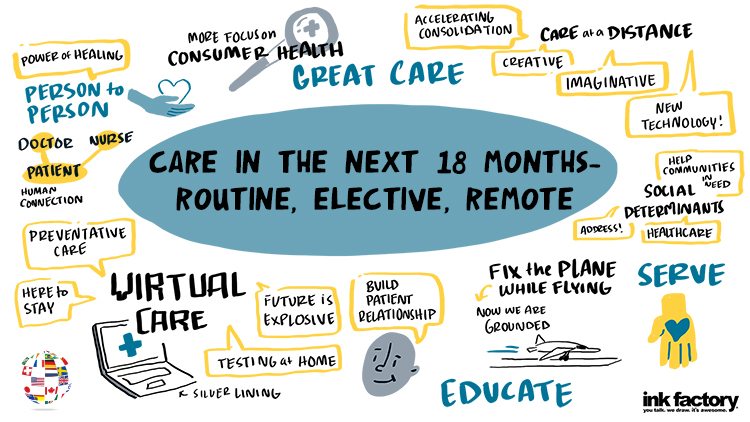WMIF MAIN SITE
2025 Event Site
At the 2020 World Medical Innovation Forum, hospital chief executives reflected on how health care will evolve over the next 18 months in the face of COVID-19. Panelists considered which changes within the hospital will stick, predicted how we will deliver care in the future, and explained the most fundamental changes within healthcare arising as a result of the pandemic.
Most of the change has been positive, so there are high hopes that those improvements will stick. The biggest change so far: telemedicine. Connecting patients from their homes to their doctors has been impactful, as is the interstate use of telemedicine. “We have the opportunity to redesign as we recover,” said John Fernandez, President of Massachusetts Eye and Ear.
The change that will be the most fundamental and lasting as a result of the pandemic is the relationship between patient and doctor/nurse. During this time, there has been a no visitor policy. Very sick individuals have been cared for by healthcare teams, and since patients are unable to see their families, these healthcare teams become their family in many ways. The human connection between patient-clinician will continue to be strongly valued.
What change needs to be reversed? Due to the virus, patients are afraid to physically go to the doctor’s office to seek care. Only 20% of hospital patient care is for COVID-19 patients: “Our hospitals are the safest places patients can be right now. We have implemented extraordinary measures to segregate COVID-19 patients from other parts of the hospital,” Elizabeth Nabel, MD, President of Brigham Health explained. “Many of our patients were afraid to come to the hospital, and now they are returning much sicker than if they had come sooner. The message we want them to know is that they are safe, and they must come back for care.”
There has been an extremely high growth of virtual care, which is going to be the path for care in the future. “I think it’s going to be explosive,” said John Fernandez. We will have to adapt our sites; our locations will be where patients get tested, images done, and procedures are done, and at home, appointments will be available for when you have a concern. This will help with preventative medicine, so people get ahead of the game instead of waiting too long to address an illness or symptom.”
“Both patients and providers are realizing a lot of things can be done in terms of virtual care,” said Peter Slavin, MD, President of Massachusetts General Hospital. “I don’t think virtual care will slow down, it is here to stay in a big way.”
There are certain populations that have been hit harder with the virus. “One of the things we have been doing is working closely with these communities to partner with them and tackle this illness,” said Peter. “We increased testing to those areas and sent care kits to houses, which include items such as hand sanitizer. We need to move upstream and address the social determinants of health. The inequities are painful, and this experience will motivate change.”